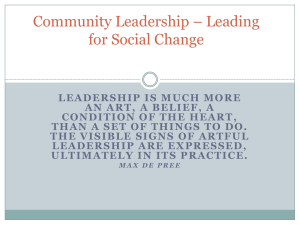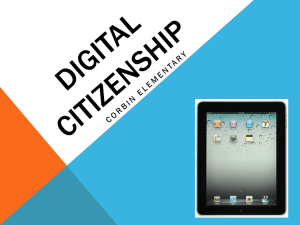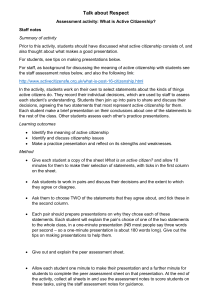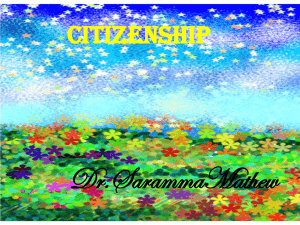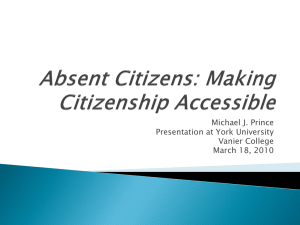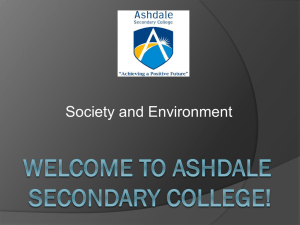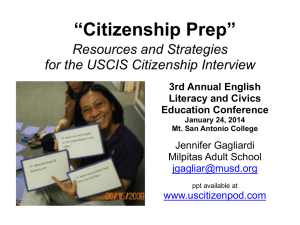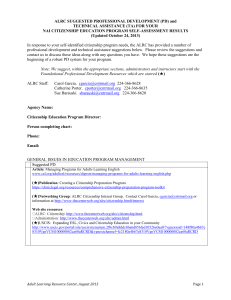CA 3/4 Adult ESL Citizen & US History
advertisement
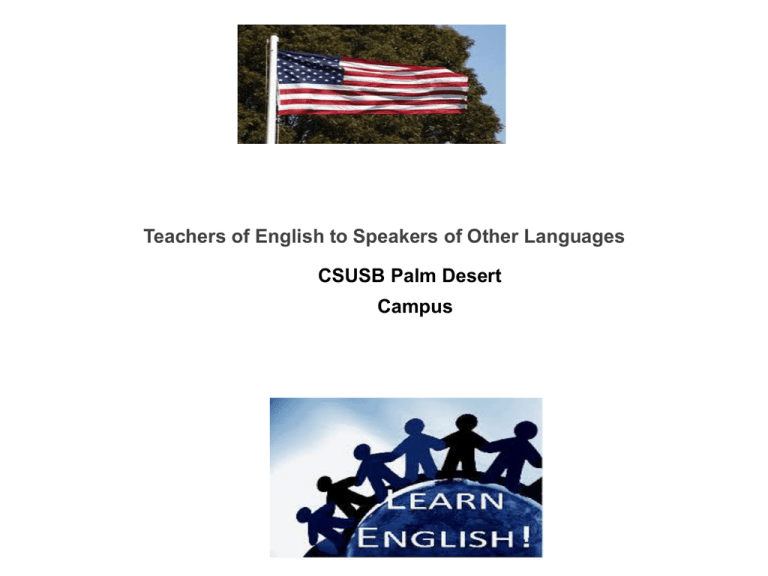
Teachers of English to Speakers of Other Languages CSUSB Palm Desert Campus California State University San Bernardino Palm Desert Campus ESL Citizenship & US History Adult & Diverse Learners Instructor: Mr. Paul Akerlund Spring Semester, 2014 Advantages of USA Citizenship • Right to Vote: Ability to elect leaders of this nation in an exclusive right of US citizens. Becoming one of them gives you the right to vote in federal elections! Get a voice! • Reunite your family in the United States: To promote family unity, US citizens and legal residents are allowed to petition for certain qualified relatives to come and live permanently in the United States. Usually, the only US citizens get priority when petitioning for loved ones. Bring your family to the USA! • Obtain citizenship for children born abroad: If you are a US citizen and your child was born outside of the county, he or she could become a US citizen automatically. • Ability to travel freely across US borders: Enjoy all the benefits of overseas travel with US passport! Get assistance from the US government and feel protected during your trips! Remember that as a US citizen the amount of time you spend outside the county is not restricted. Permanent Residents, on the other hand, may lose their status if they leave the county for a certain period of time. • Collect benefits: Take advantage of US benefits like social security and Medicare. • Become a federal employee: To be eligible for most federal jobs you need to be a US citizen. You can apply and enjoy the benefits of being a federal worker! • Become an elected official: Most elected posts in this county require US citizenship. Get the right to participate! Instructional Strategies & Evaluation Procedures • Small group instruction • Grouping within content areas • Lecture method Listening : Demonstrate understanding of simple questions, statements, and conversations using citizenship/civics vocabulary. • Listen and identify specific information in context of lessons and identify unfamiliar vocabulary • Identify main ideas and information which supports the factual events in US history, citizenship, and geography of the United States. • Demonstrate the understanding of basic commands • Understand questions about everyday life and events • Understand oral questions asked on the Application for Naturalization, Form N-400 • Understand oral questions on the citizenship review civics test Speaking: Summarize short oral and written accounts of US History using visual prompts. Respond to written and visual information by answering questions orally, summarizing a paragraph, describing a scene, or retelling a story. Engage in basic conversations in English Make statements of personal information Respond to questions by instructor for clarification Construction clarifying questions regarding the Naturalization process Provide complete answers to civics questions by instructor Use simple strategies to check for understanding. Knowledge and Understanding of the English Language Cooperative learning: Types of Cooperative Learning: Peer tutoring, cooperative projects, cooperative individual projects, cooperative interaction. Emphasis on Manufactured materials, Modeled materials, Modified materials to study: United States History 1877- Present United States Government United State Geography Basic Economics Rationale for Using Cooperative Learning: Educational Democracy Race Relations Prosocial Development a.) Family Structure b.) technology c.) competitive and Individualistic school practices d.) Social Skills Acquistion LANGUAGE SKILLS –Reading •Interpret simplified short narratives and descriptive passages with US. Constitution and United States History. •Integration of US History, Government, Civic engagement, and the naturalization process into ESL English classes. •Employ strategies to learn about the USA and increase English language Acquisition. • -Activity • Each student will identify one public policy promoting competent and responsible participation in state, local, and federal government. Three identifications per student on each level of government. This activity actively engages the emerging immigrant to promote competency and responsibility of their new citizenship. •Each student will create a portfolio that they then orally present utilizing language skills . Their individual presentations will first be before their own groups and then with practice in front of the class. • -Facilitating Reasoning and Practical Skills •The objective of the lesson then is to have students demonstrate what they have learned and in this portfolio activity the instructor can measure both competencies and understanding. •This activity then allows for positive feedback to each student on their portfolio and a review orally involving questions about our government and combined formal and informal feedback. Relative to the lessons on governmental bodies it allows students to both refocus, review, and further guide students into competencies that will require testing to gain US citizenship. •Continued opportunities to discuss US history and our government will support cognition and attitudinal behaviors as discussed in Victor M. Hernandez-Gantes book titled: “Teaching Englsh Language Learners in Career and Technical Education Programs. • -Teaching for Understanding •Involve students in more content based instruction which will allow acquisition of further language competencies and rote memorization of words and facts necessary to pass the testing components. • R ACCOMMODATING STUDENTS’ LEARNING MODALITIES • Visual Learners Use of visual aids, Vocabulary, Technology • Auditory Learner • Sounds, Re-entering, Pacing • Kinesthetic Learners • Manipulative, games, peer tutoring, total physical response • Global Learner • (Right hemisphere: spatial order) • Likes the whole picture, is impulsive, process simultaneously, is spatial, seeks patterns • Analytical Learner • (Left hemisphere: linear, step by step • Pieces together pieces • Is critical • Process sequentially • Is temporal • Seeks parts • For Group Work to find Success: • form groups quickly and quietly, use soft voices, stay within grouping, take turns in participation, • include everyone, watch the clock, stay on task, be polite, monitor our language, offer help/ask for help, look at and listen to each member of group, use each others names, clarify instructions • Building Group skills: • Practice speaking more, have more of a chance to listen, learn from each other, ask for help and give help, share information, learn to compromise, learn to lead and learn to follow, share successes, create together, learn more quickly, have more FUN! “Sheltering” Lessons for Effective Content Instruction for ESL Simplify Input: Slower speech rate ( Longer Pauses between phrase, clear enunciation, Controlled Vocabulary, limited idiomatic speech, controlled sentence length. Check For Understanding: Utilize questions and directions that allow students to show comprehension in ways appropriate for their language level --pointing or gesturing --nodding or shaking their heads --performing an act as directed --responding “yes” or “no” --making short simple statements Focus on the meaning of the students responses Repeat, relate, expand, give examples as necessary Check for mastery or topic in a variety of ways Review main topics and key vocabulary Use Contextual Clues: --Act out a meaning with gestures, facial expressions --Utilize lots of pictures, graphs, maps, visuals, manipulatives --Make frequent association between visuals and word --Model procedures --In presentations and explanation, start with the “here and now” before moving to the abstract. Empowerment in ESL Education Content Based Instruction for US. History, Civics, Geography Listening: To help students better understand what instructor is lecturing - simplify input, Focus questions, body language, objects, visual clues, note taking, audio taping lessons, prior knowledge ( access students prior knowledge) , key vocabulary, check for Understanding Recap key points. Speaking: Provide frequent opportunities for ESL students to speak through the use of : Small groups, cooperative learning, Wait time, I don’t understand, Point and view opinions, Paraphrasing, Brainstorming Reading: To help ESL students learn more effectively from printed material utilize : graphic organizer, vocabulary, discussion , re write materials, alternative material Sheltering and Teaching Content Prior Knowledge: New information needs to be linked t students’ relevant prior knowledge. Technical Vocabulary: Teach vocabulary utilizing US history and US citizenship. Learning Styles: Employ visual, auditory, and kinesthetic means of presenting new content. Utilize multi sensory experiences. Overview: This technique will provide students with a general understanding of major points that they will be studying and how these points are interrelated. Questioning: Model higher-order thinking skills. Ask students to predict, speculate, synthesize, and make judgement abut the content material they are learning rather then merely recalling the facts. Teacher Monitoring: Constantly monitor student’s comprehension of the content Sequencing Instruction & Learning Strategies ESL • Remediation of a student’s ineffective problem-solving skills regarding social interactions and task performances. • Personal recognition and bonding activities to increase self-esteem, affiliation, and a sense of belonging with school. • Frequent teacher feedback involving parents and students regarding classroom comportment and assignments. • Integration of school and community. • Timeline: Sequencing , relationships • Conferencing: Utilization of previous knowledge, peer tutoring, collaboration, review, critical thinking • Brainstorm Lists: Critical, creative thinking • Mingling: Physical interaction, reviewing • Peer dictations: Oral pronunciation of English vocabulary in citizenship and US history • Graphic Organizers: Organizing a whole view of essential points, previewing, reviewing, classifying, comparing, contrasting. • Graphic Outlines: Skimming, organizing, general global information, previewing, reviewing, predicting. • Physical representations: Making “spacial relationships” more concrete, imagery, physical involvement, interaction, peer tutoring


